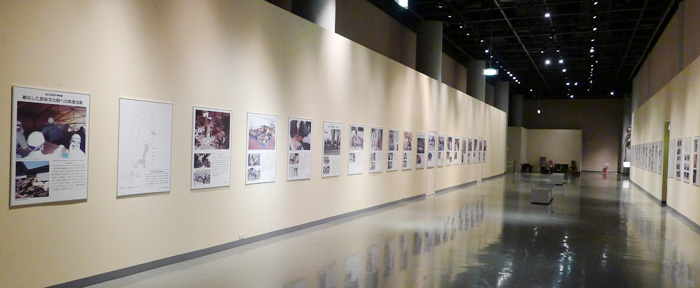Transmitting Memories: Tsunami Disaster and Cultural Heritage


- Location: Thematic Exhibition Hall A, National Museum of Ethnology
- Exhibition Period: September 27 - November 27, 2012
- Hours: 10:00 a.m. – 5:00 p.m. (Entry is permitted until 4:30 p.m.)
- Closing days: Every Wednesday (If Wednesday is a national holiday, closed the following day instead)
- Admission Free Days: November 3 (Culture Day), 17, 18 (Kansai Culture Day)
-
※Admission fee for the Main Exhibition Building is required. Details
※Admission is free every Saturday for elementary, junior high, and senior high school students. Those visitors will, however, need to pay the admission to the Natural and Cultural Gardens (¥250) separately if they wish to enter that way. - Organized by the National Museum of Ethnology, the National Museum of Japanese History, and the National Institute of Japanese Literature
- Supported by the National Institutes for Cultural Heritage, the Japan Society for the Conservation of Cultural Property, the Japan Society for Scientific Studies on Cultural Properties, the Society for MINGU of Japan, the Folklore Society of Japan, the Otemon Gakuin University Local Culture Creation Institute, and the Senri Foundation
- With cooperation from Sankei Shimbun and Kyodo News
The devastating damage caused by the massive March 11, 2011 earthquake has imposed a severe ordeal upon Japan. The damage, including that to nuclear power plants, is profound and continues to unfold. The effects of this huge earthquake are still emerging.
With the very survival of local communities still in doubt, the year following the disaster has seen a resurgence of local festivals and offerings of theatrical performances in greater numbers than in ordinary years. The result has been a reawakening of the importance of both tangible and intangible cultural assets to people’s lives.
Efforts to revive cultural heritage have received support in many forms. Minpaku (the National Museum of Ethnology) has joined hands with our fellow National Institutes for the Humanities, the National Museum of Japanese History and the National Institute of Japanese Literature, and other institutions to help provide support for those efforts.
We see this thematic exhibition as an opportunity to refocus on the work of reviving cultural heritage, rethinking its significance, and, via cultural heritage, ensuring that memories of the earthquake and tsunami are transmitted to future generations and contribute to building a next-generation society.
![[img]](/sites/default/files/museum/exhibition/thematic/kioku20120927/img/kioku20120927_zuroku.jpg)
The exhibition catalogue, Kiroku wo tsunagu—tsunamisaigai to bunka isan (Connecting memories—the tsunami disaster and cultural treasures), edited by Hidaka Shingo (Associate Professor, Minpaku), is available in the Minpaku museum shop.

![[img]](/sites/default/files/20121118_flyer.jpg)
Download the flyer
[PDF:4.9MB]
Date: 2:30 – 3:30 p.m., November 18
Location: The Entrance Hall on the 1st Floor of the Main Exhibition Building, National Museum of Ethnology
Performance goals: The Annual Nambu-han Jushoin Grand Kagura Performance, based in Tadakoshi-cho, Kamaishi City, Iwate Prefecture, is said to have begun in 1699, when a shrine dedicated to Ozaki Daimyojin, the guardian deity of the city of Kamaishi, was constructed. Of the annual events that managed ascetic practices by region in the Morioka domain, the kagura performance was entrusted to the Jushoin temple, which was responsible for the Hei-gun area, and was presented as an offering to the object of worship.
The annual Grand Kagura is performed today at festivals associated with Kamaishi’s three principal shrines, the Kamaishi Grand Tutelary Yakumo Shrine, the Ozaki Shrine, and the Watatsumi Shrine. The kagura performance heralds the arrival of the deities and is placed at the very front of the procession when the objects of worship are paraded through the territories they protect. In the Hikibune Festival, which welcomes the Ozaki Shrine’s object of worship from its main shrine to the local shrine, one float is designated as the gokagurabune, the float on which kagura dancing is performed. It leads the way for the float carrying the deity and is responsible for exorcising evil spirits from all the households in the community.
Even in Kamaishi City, with its rich heritage of many different forms of traditional performance, Grand Kagura stands out for its status, proud history, and pedigree. Grand Kagura was severely impacted by the Great East Japan Earthquake.
For details

![[img]](/sites/default/files/20121021_flyer.jpg)
Download the flyer
[PDF:2.1MB]
free of charge, no reservation needed (first come, first served).
Purpose: To promote the revival of local culture in a region affected by the Great Northeast Japan Earthquake and Tsunami. This event is related to Minpaku's engagement with the restoration of tangible and intangible culture, and will coincide with the Kioku wo tsunagu (Connecting Memories) exhibition that opens on September 27. The exhibition will show how Minpaku is helping to restore cultural treasures, and aims to arouse interest in this effort. We are proud to present the Shimoheigunfudaimurai troupe performing U no tori shinraku. This is a rare opportunity to see an example of traditional culture from the Sanriku coast, and at the same time support the revival of earthquake and tsunami-affected communities.
Location: Thematic Exhibition Hall A, National Museum of Ethnology
Exhibition Period: May 31 – August 21
This exhibition presents photographic panels created for the Transmitting Memories—Tsunami Disaster and Cultural Heritage exhibition, which opened on September 27. These panels are displayed along with Historic Earthquakes and Tsunamis in Sendai-heiya—Memories of Disasters in Earth and Words, created by the Sendai City Museum, which is located in the Tohoku region afflicted by the March 11, 2011, earthquake and tsunami. Together they introduce the cultural treasure rescue efforts undertaken in the wake of that disaster by the National Museum of Ethnology, the National Museum of Japanese History, and the National Institute of Japanese Literature, all National Institutes for the Humanities. They also introduce the Love Deer Project, through which support was provided for Ofunato City’s Deer Dance Festival. We hope that these exhibits will inspire thought on how we all can participate in relief efforts for the Tohoku region in the wake of this unprecedented calamity.
 |
この企画展は国文学研究資料館で以下の期間に開催されます。

国文学研究資料館 http://www.nijl.ac.jp/
会場:国文学研究資料館 大会議室
日時:2013年3月8日(金)13:00~16:00






